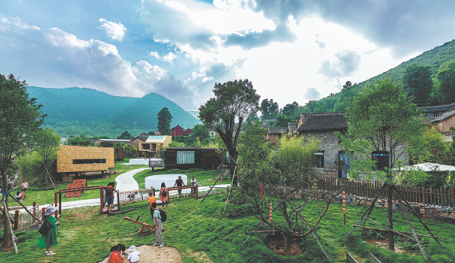On a sunny autumn day, Jia Baocheng sat in front of his three-floor inn in Qiaoshang village, greeting the backpackers who climbed mountains in the early morning.
Surrounded by flowers and lush green hills, the inn with 12 rooms has seen a boom in business despite its location in the middle of a mountain valley.
Qiaoshang is located in the heart of the Taihang Mountains and was once a poverty-stricken village in Huguan county, Shanxi province. The ancient village boasts beautiful natural scenery like a grand gorge with flowing water and dense forests, but had long been little-known due to poor road connectivity and public infrastructure.
It was the emerging rural tourism industry that made changes happen. In recent years, Qiaoshang has gained support from provincial authorities for tourism-based poverty reduction, and made many efforts to improve infrastructural facilities and develop natural attractions.
The village is now recognized as one of the most beautiful and livable tourism villages in Shanxi. The lives of local residents have also changed dramatically.
In Shanxi, tourism resources in rural areas account for 70 percent of the province's total. Making use of its natural advantages, Shanxi has promoted the rapid development of sightseeing, relaxation, bed-and-breakfast accommodations and other tourism-related businesses in its villages. It has made heavy investments in building public infrastructure such as roads, water supply facilities, parking lots and public toilets in rural areas.
Yuejiazhai in Pingshun county is another village benefiting from the development of rural tourism. The village, covering an area of 16 square kilometers, is famous for its stone buildings, waterfalls, rainbows and misty clouds.
However, Yuejiazhai had no chance to show these breathtaking sceneries to the outside world until 2009, when it completed the construction of a road network. Since then, the village has vigorously developed the tourism industry featuring ecological agriculture, leisure, sightseeing and local traditional craftsmanship.
"To date, we have received about 1 million tourist visits from people attracted by the scenic spots, and earned a total of 100 million yuan ($15.48 million) in tourism income," said Yue Xianlai, secretary of the village's Party branch.
"We have also boosted tourism and economic development of the nearby villages, and made contributions to the implementation of the rural revitalization strategy," he added.
Since then, more villages have turned clear waters and green mountains into "mountains of gold and silver", said Wang Aiqin, chief of the Shanxi Culture and Tourism Department. The official said rural tourism has become an important way to realize the province's rural revitalization, and equal attention has gone to the quantity and quality of the industry's development.
The department will continue to help strengthen sightseeing tourism in the years to come, Wang said. It will also develop leisure and recreational activities at the same time.
Another focus is the combination of rural tourism and healthcare, according to the department. "Shanxi has unique terrain, climate, food and traditional Chinese medicines, which are all conducive to the integrated development of the two industries. Their combination is one of the best choices to diversify tourism services and extend the tourism industrial chain," Wang said.
Songmiao village in Lingchuan county, for example, has successfully helped farmers beef up their income by developing tourism and healthcare industries. The ancient village has planted 680 mu (45 hectares) of medical herbs and boasts a forest coverage rate of 95 percent.
This year, the village cooperated with Xuanwu Hospital in Beijing to set up a convalescent facility for relieving sleep disorders. It has developed "sleep-aiding" tours by providing herbal baths, and building roads and facilities friendly for hiking, cycling and walking.
During this year's Labor Day holiday from May 1 to 5, Songmiao received 50,000 visits and its tourism revenue totaled 1 million yuan.
In the coming five years, Shanxi plans to build a group of communities and villages with health tours as their main characteristics. It also wants to build a healthcare industrial cluster integrating tourism, accommodations, leisure and medical care, which is expected to generate 100 billion yuan in revenue through 2025, according to the provincial government.

Tourists have a boat tour of the Niangziguan village in Pingding county. CHINA DAILY

Songmiao village in the county of Lingchuan is known as a convalescent destination that offers 'sleep-aiding' tours. WANG JIANJUN/FOR CHINA DAILY

Qiaoshang in Huguan county is recognized as one of the most beautiful and livable tourism villages in Shanxi. SONG XIAO/FOR CHINA DAILY

